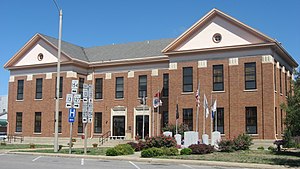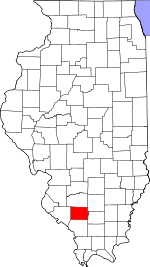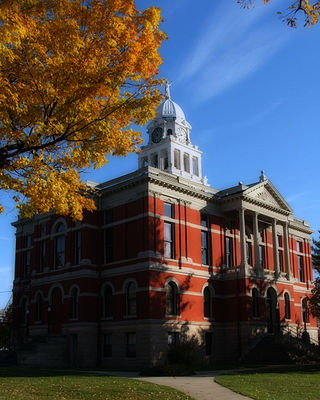
Eaton County is a county in the U.S. state of Michigan. As of the 2020 United States Census, the population was 109,175. The county seat is Charlotte. The county was organized in 1837 and was named for John Eaton, who was Secretary of War under U.S. President Andrew Jackson, making it one of Michigan's Cabinet counties. Eaton County is included in the Lansing-East Lansing, Metropolitan Statistical area in Central Michigan.
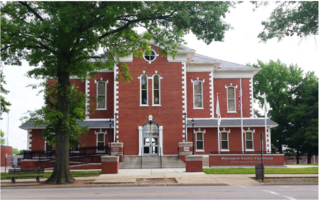
Washington County is a county located in the U.S. state of Illinois. As of the 2020 census, it had a population of 13,761. Its county seat is Nashville. It is located in the southern portion of Illinois known locally as "Little Egypt".

Randolph County is a county located in the U.S. state of Illinois. According to the 2020 census, it had a population of 30,163. Its county seat is Chester.
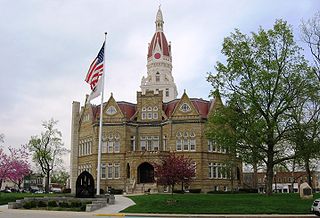
Pike County is a county in the U.S. state of Illinois. It is located between the Mississippi River and the Illinois River in western Illinois. According to the 2020 United States Census, it had a population of 14,739. Its county seat is Pittsfield.
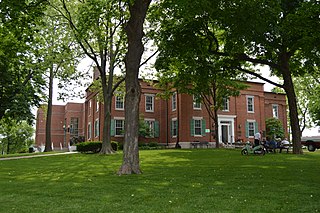
Monroe County is a county located in the U.S. state of Illinois. According to the 2020 census, it had a population of 34,962. Its county seat and largest city is Waterloo.
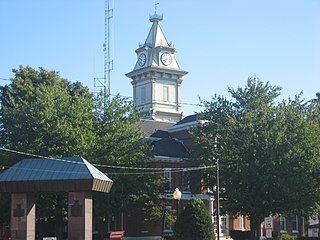
Edwards County is a county located in the U.S. state of Illinois. As of the 2020 census, the population was 6,245. Its county seat is Albion.

Wamac is a city in Washington, Marion, and Clinton counties in the U.S. state of Illinois. The population was 985 at the 2020 census, down from 1,185 in 2010. Incorporated as a city on July 25, 1916, Wamac derives its name from the three counties.

Dowell is a village in Jackson County, Illinois, United States. The population was estimated to be 385 at the 2020 census, down from 408 at the 2010 census.

Du Quoin is a city in Perry County, Illinois. It is best known for hosting the annual DuQuoin State Fair and the Street Machine Nationals. The population is estimated at 5,761 in the 2020 census.

Pinckneyville is a city in and the county seat of Perry County, Illinois, United States. The population was 5,066 at the 2020 census. It is named for Charles Cotesworth Pinckney, an early American diplomat and presidential candidate.

Tamaroa is a village in the Tamaroa Precinct of Perry County, Illinois, United States. The population was 638 at the 2010 census.
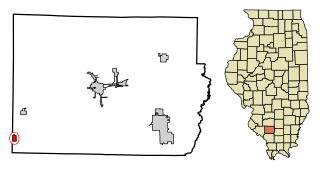
Willisville is a village in Perry County, Illinois, United States. The population was 633 at the 2010 census.
Lusk's Ferry Road was an early road in Illinois that provided an overland connection between the main settlement, Fort Kaskaskia, on the Mississippi River, and Lusk's Ferry, an important crossing point on the Ohio River. The overland route afforded an alternative to the river route, which required a difficult trip upstream on the Mississippi.

The Du Quoin State Fairgrounds are located in the city of Du Quoin in Perry County, Illinois, United States. The fairgrounds are located along U.S. Route 51 north of Illinois Route 14. The facilities include the DuQuoin State Fairgrounds Racetrack, an oval track that has hosted AAA, USAC and ARCA races since 1948. The fairgrounds are also home to a horse racing track which hosted the Hambletonian Stakes from 1957 to 1980 and the World Trotting Derby from 1981 to 2009.

Barrington Township is one of 29 townships in Cook County, Illinois, USA. As of the 2020 census, its population was 16,514 and it contained 6,172 housing units. The northwestern corner of the Cook County panhandle, it is the county's northwesternmost township. It is also by far the least densely populated township in the county, with less than half the population density of the next least Lemont Township.

Metro Lakeland is a name that was coined in the 1960s for an area of southern Illinois that is centered on the intersections of Interstate 57, Interstate 24, and Illinois Route 13 — a four-lane east-west highway connecting the communities of Murphysboro, Carbondale, Carterville, Herrin, Marion, and Harrisburg. Metro Lakeland was defined as Jackson, Williamson, Franklin, Saline, and Perry counties, with a combined population of approximately 210,000. Carbondale, Herrin, and Marion are the key urban areas, with a combined city-proper population of over 65,000 Carbondale, the site of Southern Illinois University, is the region's largest city. Metro Lakeland is about 88 miles (142 km) southeast of St. Louis, Missouri, or 120 miles (190 km) by Interstate highway.

Elk Township is one of sixteen townships in Jackson County, Illinois, USA. As of the 2010 census, its population was 1,907 and it contained 873 housing units.
Sunfield is an unincorporated community in Perry County, Illinois, United States. Sunfield is 3.5 miles (5.6 km) north of Du Quoin. An F5 tornado struck 1 mile north of the village at the US Route 51/State Route 154 intersection on December 18, 1957, killing one person.
Paul Jacobs is a Republican member of the Illinois House from the 115th district since January 13, 2021. The 115th district includes all or parts of Alto Pass, Anna, Ashley, Ava, Belle Rive, Bluford, Bonnie, Campbell Hill, Carbondale, Centralia, Cobden, De Soto, Dix, Dongola, Du Bois, Du Quoin, Elkville, Gorham, Grand Tower, Harrison, Ina, Jonesboro, Makanda, Mill Creek, Mount Vernon, Murphysboro, Nashville, Opdyke, Pinckneyville, Radom, Richview, St. Johns, Tamaroa, Vergennes, Waltonville, and Woodlawn.
